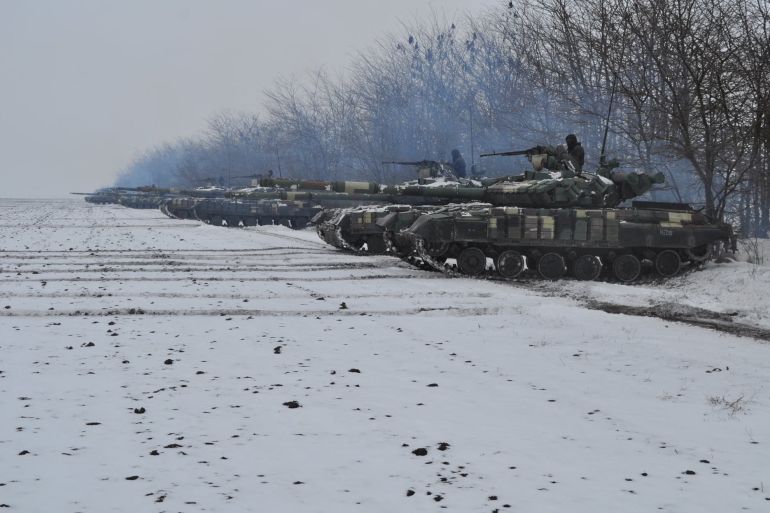Ukraine-Russia crisis: What is the Minsk agreement?
France’s Macron says the 2015 ceasefire deal between Kyiv and Moscow offers a ‘path’ to peace.

French President Emmanuel Macron has pointed to the 2015 Minsk Agreement between Kyiv and Moscow as the blueprint for a breakthrough in the Ukraine crisis.
Following talks with his Russian and Ukrainian counterparts, Macron said on Tuesday that the Minsk II agreement – which was aimed at ending the war in eastern Ukraine – is the “only path on which peace can be built”.
Keep reading
list of 4 itemsMariupol: War fears in Ukraine’s vulnerable frontier city
Russian war games in Belarus designed to ‘send Ukraine a message’
Borderlands: Fear and uncertainty on Ukraine’s front line
But the deal, named after the Belarusian capital where it was settled, was never fully implemented.
It came on the back of Minsk I, an earlier failed attempt at a ceasefire agreement.
Brokered by France and Germany, Minsk II again sought to halt the conflict that began when Russia-backed separatists seized swaths of territory following Russia’s 2014 annexation of the Crimean Peninsula.
But years on, there has been no full political settlement and deadly fighting between Ukraine and the rebels continues.
Here’s what you need to know:
What are the Minsk agreements?
Minsk I
Ukraine and the Russia-backed separatists agreed on a 12-point ceasefire deal in September 2014.
Its provisions included prisoner exchanges, deliveries of humanitarian aid and the withdrawal of heavy weapons. However, the agreement quickly broke down, with violations by both sides.
Minsk II
Representatives of Russia, Ukraine, the Organisation for Security and Cooperation in Europe (OSCE) and the leaders of separatist-held regions Donetsk and Luhansk signed a 13-point agreement in February 2015.
The leaders of France, Germany, Russia and Ukraine gathered in Minsk to mark the occasion and issued a declaration of support.
The deal’s 13 points were:
- Immediate, comprehensive ceasefire.
- Withdrawal of heavy weapons by both sides.
- OSCE monitoring.
- Dialogue on interim self-government for Donetsk and Luhansk, in accordance with Ukrainian law, and acknowledgement of special status by parliament.
- Pardon, amnesty for fighters.
- Exchange of hostages, prisoners.
- Humanitarian assistance.
- Resumption of socioeconomic ties, including pensions.
- Ukraine to restore control of state border.
- Withdrawal of foreign armed formations, military equipment, mercenaries.
- Constitutional reform in Ukraine including decentralisation, with specific mention of Donetsk and Luhansk.
- Elections in Donetsk and Luhansk.
- Intensify Trilateral Contact Group’s work including representatives of Russia, Ukraine and OSCE.
Why has the 2015 agreement failed to end fighting in eastern Ukraine?
The Minsk II deal set out military and political steps that remain unimplemented.
A major blockage has been Russia’s insistence that it is not a party to the conflict and therefore is not bound by its terms.
In general, Moscow and Kyiv interpret the pact very differently, leading to what has been dubbed by some observers as the “Minsk conundrum”.
What is the ‘Minsk conundrum’?
Ukraine sees the 2015 agreement as an instrument to re-establish control over the rebel territories.
It wants a ceasefire, control of the Russia-Ukraine border, elections in the Donbas, and a limited devolution of power to the separatists – in that order.
Russia views the deal as obliging Ukraine to grant rebel authorities in Donbas comprehensive autonomy and representation in the central government, effectively giving Moscow the power to veto Kyiv’s foreign policy choices.
Only then would Russia return the Russia-Ukraine border to Kyiv’s control.
Why is the agreement in focus now, and how might it help resolve the crisis?
The Minsk II deal offers a vehicle for direct talks between Ukraine and Russia and, due to France’s mediating role in the agreement, provides Macron with the opportunity to play the peacemaker on the world stage as he gears up for re-election at home.
Moscow may see Minsk II as a way to guarantee its central security demand – that Ukraine is never allowed to join NATO. Washington and NATO have already rejected that demand.
For ex-Soviet state Ukraine, the deal could present an opportunity to wrest back control of its border with Russia and end the threat of Moscow ordering another invasion, at least for now.
Kyiv says it will never allow Russia to have a de facto veto on Ukrainian foreign policy decisions, and many in Ukraine see the fulfilment of Minsk II as a concession to Russian aggression. But there may be room for compromise – all parties have expressed willingness for dialogue.
What might happen next?
Macron said on Tuesday that envoys from France, Germany, Russia and Ukraine will meet in Berlin for so-called “Normandy Format” talks on Thursday, two weeks after a previous round in Paris.
That meeting marked the first in-person gathering of political advisers from the four countries which were involved in the Minsk II accord for more than two years.
Separately, the United Nations Security Council (UNSC) is set to hold a discussion next week on the implementation of the peace deal. The February 17 meeting will become the latest in a string of regularly scheduled UNSC talks on the agreement, which was endorsed by the council in 2015.